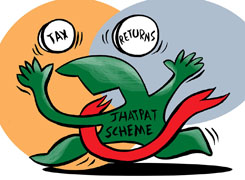Mihir Tanna |1070 Answers |Ask -Follow
Tax Expert - Answered on Jul 21, 2023
He handles various kinds of matters related to direct tax such as PAN/ TAN application; compliance including ITR, TDS return filing; issuance/ filing of statutory forms like Form 15CB, Form 61A, etc; application u/s 10(46); application for condonation of delay; application for lower/ nil TDS certificate; transfer pricing and study report; advisory/ opinion on direct tax matters; handling various income-tax notices; compounding application on show cause for TDS default; verification of books for TDS/ TCS/ equalisation levy compliance; application for pending income-tax demand and refund; charitable trust taxation and compliance; income-tax scrutiny and CIT(A) for all types of taxpayers including individuals, firms, LLPs, corporates, trusts, non-resident individuals and companies.
He regularly represents clients before the income tax authorities including the commissioner of income tax (appeal).... more

मैं पहली बार आईटी रिटर्न दाखिल कर रहा हूं। मेरे पास निम्नलिखित प्रश्न हैं. मेरी आय 10 एलपीए है. आईटीआर कैसे और कहां दाखिल करें? क्या मुझे खुद फाइल करनी चाहिए या सीए से मदद लेनी चाहिए? कौन सा फॉर्म चुनना है? मेरे ऊपर कोई ऋण नहीं है. क्या मैं एसआईपी और म्यूचुअल फंड निवेश पर कर का दावा कर सकता हूं? यदि मैं कोई गलती करता हूँ तो क्या मैं उसे सुधार सकता हूँ? कृपया मदद करें
टैक्स सेवर म्यूचुअल फंड में निवेश के मामले में धारा 80सी के तहत 1,50,000 रुपये की ऊपरी सीमा के साथ कटौती ली जा सकती है।
संशोधित रिटर्न दिसंबर तक दाखिल किया जा सकता है.
आप नीचे ऐसेही प्रश्न और उत्तर देखना पसंद कर सकते हैं
Mihir Tanna |1070 Answers |Ask -Follow
Tax Expert - Answered on Feb 07, 2023
Vivek Lala | Answer |Ask -Follow
Tax, MF Expert - Answered on Jun 24, 2024
Nayagam P P |10230 Answers |Ask -Follow
Career Counsellor - Answered on Aug 13, 2025
Nayagam P P |10230 Answers |Ask -Follow
Career Counsellor - Answered on Aug 13, 2025
Dr Nagarajan J S K |2267 Answers |Ask -Follow
NEET, Medical, Pharmacy Careers - Answered on Aug 13, 2025
Radheshyam Zanwar |6312 Answers |Ask -Follow
MHT-CET, IIT-JEE, NEET-UG Expert - Answered on Aug 13, 2025
Radheshyam Zanwar |6312 Answers |Ask -Follow
MHT-CET, IIT-JEE, NEET-UG Expert - Answered on Aug 13, 2025
Radheshyam Zanwar |6312 Answers |Ask -Follow
MHT-CET, IIT-JEE, NEET-UG Expert - Answered on Aug 13, 2025
Radheshyam Zanwar |6312 Answers |Ask -Follow
MHT-CET, IIT-JEE, NEET-UG Expert - Answered on Aug 13, 2025
Nayagam P P |10230 Answers |Ask -Follow
Career Counsellor - Answered on Aug 13, 2025
Nayagam P P |10230 Answers |Ask -Follow
Career Counsellor - Answered on Aug 13, 2025
Nayagam P P |10230 Answers |Ask -Follow
Career Counsellor - Answered on Aug 13, 2025






















